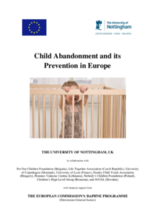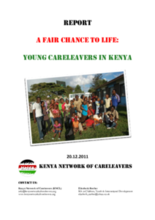Demographic Data
|
Sources: World Bank, UNICEF, UNDP HDR 2015, DHS 2014 |
Displaying 12901 - 12910 of 14390
This comprehensive manual provides an overview of child abandonment and its prevention in Europe, exploring the extent of child abandonment, possible reasons behind this phenomenon, the consequences of abandonment, and good practices in terms of prevention. For the purposes of the EU Daphne-funded project, child abandonment is defined in two ways, namely open and secret abandonment. Country specific in-depth reviews of child abandonment and its prevention are provided for 10 countries and results from an EU-wide survey analyzed.
Documenting the young people‘s own views of what has happened during the time of leaving care and afterwards, this study explores in-depth the experiences of care leavers during the dynamic phase following their separation from an institutional care setting.
Study to understand prevailing attitudes towards residential care in Cambodia and to generate evidence for policy development and advocacy
This document is a Slovakian language summary brochure of the Manual of Best Practice titled ‘Child Abandonment and its Prevention in Europe,’ specific to child abandonment in Slovakia.
Using a nationally representative household survey conducted in 2006-2007 in Senegal, this study sheds light on the common practice of fostering (confiage) by examining the characteristics of households and individuals involved in fostering, the motivation for fostering and its impact on host households, sending households, and the foster child, with a focus on education, employment and marriage outcomes.
This study explores global growth suppression among children within institutional care settings.
This paper from Monographs of the Society for Research in Child Development Volume 76, Issue 4 proposes a number of key components for translating research into policy and programs: analyzing the situation, using evidence to build the case for action, developing policies, building program capacity in child welfare and early childhood development, creating a family‐based child welfare system, and developing a system of monitoring and accountability.
Utilizing the United Nations Convention on the Rights of the Child and the Guidelines for the Alternative Care of Children, this paper from Monographs of the Society for Research in Child Development Volume 76, Issue 4 examines critical components and current characteristics of alternative care for children in low‐resource countries.
This chapter from Monographs of the Society for Research in Child Development Volume 76, Issue 4 reviews sensitive periods in human brain development based on the literature on children raised in institutions.





